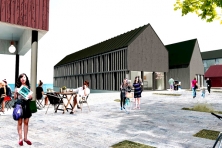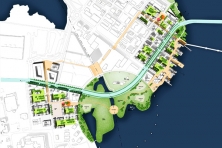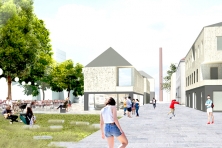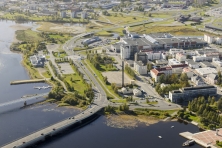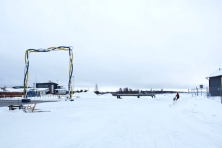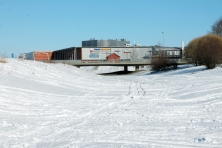Two Cities One Heart
TornioHaparanda (FI) - Winner
TEAM DATA
Team Representative: Vilma Autio (FI) – architect
Associates: Hanna Kuivalainen (FI), Maija Parviainen (FI) – architects
TREA Team for Resilient Architecture
+358 407 499 483 - vilma.autio@trearchitecture.fi - trearchitecture.fi
See the complete listing of portraits here
See the site page here

V. Autio, H. Kuivalainen & Maija Parviainen
INTERVIEW
Click on the images to enlarge
1. How did you form the team for the competition?
Vilma Autio, Hanna Kuivalainen and Maija Parviainen have studied together in the Aalto University, and have all previously been members of the workspace collective Nuorten Suunnittelijoiden työhuone in Helsinki (FI). Similar design philosophy, complementary strengths and the intriguing design challenge of TornioHaparanda brought the team together for this Europan 14 competition.
2. How do you define the main issue of your project, and how did you answer on this session main topic: the place of productive activities within the city?
The primary issue of our project has been to support the co-existence and to celebrate the global uniqueness of the TornioHaparanda twin city through spatial design strategies; as well as to create opportunities for different productive activities within the urban fabric. Our interpretation of productivity ranged from small scale production and distribution to businesses and remote work. The main design intervention to cater to these functions was the transformation of the route E4 that runs through the competition area into a productive urban boulevard that offers flexible raw space by a busy route for all of the forementioned activities.
3. How did this issue and the questions raised by the site mutation meet?
The cities of Tornio (Finland) and Haparanda (Sweden) are already mentally a twin city, and we wanted to also connect them physically into one urban entity with one shared heart by stitching together the urban fabric on each side of the border. In order to do that, we developed three design strategies: The Tornio Haparanda Loop, the productive boulevard and the Rajakaari park that is defined by an array of distinctive neighbourhoods. These core strategies overlap to form the new centre for TornioHaparanda.
4. Have you treated this issue previously? What were the reference projects that inspired yours?
The issue of the twin city was something that our team had not directly addressed in the past; however we did have background and existing interest in investigating themes such as nationalism and global migration in urban contexts. As for reference projects, the context of the co-joined twin city, meaning neighbouring cities that are in close co-operation or functioning as one entity yet officially divided by a national border, is highly unique at least in the European context, and we found ourselves struggling to find references of such instances. However this also allowed us freedom to create our own interpretation of how spatial design can support such coexistence. When drafting the individual design interventions, we looked into examples of reference projects regarding the boulevardization of highways, as well as into hybrid projects combining for example production and recreation.
5. Urban-architectural projects like the ones in Europan can only be implemented together with the actors through a negotiated process and in time. How did you consider this issue in your project?
The core approach of our team as well as our proposal is the promotion of urban resiliency in the sense of ensuring the capability of an urban area to adapt to and also positively influence fluctuating environmental, social and economical phenomena. We believe that such resilient areas have a competitive edge towards thriving in our ongoing era of environmental, economical and political instability. Resilient urban strategies are especially vital for smaller municipalities in peripheral areas, such as TornioHaparanda, where the economic structure is simple and resources can be scarce, which can make them vulnerable to socio-economical alterations. Though remote, peripheral towns are in no way immune to global megatrends shaping the world. The design interventions in our proposal therefore take into consideration the long time spans and dynamic nature of urban development and have been drafted to cater to a variety of different and changing functions. We believe that the successful implementation of these interventions may only be achieved through a collaborative process with the citizens of TornioHaparanda in order to ensure the viability of all design interventions and to inspire a sense of true co-creation of the new TornioHaparanda heart.
6. Is it the first time you have been awarded a prize at Europan? How could this help you in your professional career?
This was the first time that any of the team members had either participated or had been awarded a prize in the Europan scheme, thus making us very pleased with our team’s success. The selection of our entry as the winner of the TornioHaparanda site inspired our working team to co-found architectural office TREA, through which we are now continuing co-operation with the officials and citizens of TornioHaparanda to realize the vision of our entry through further municipal planning.
